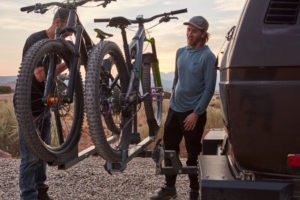Getting a new bike this year? Great! You’re on your way to enjoying all of the benefits that come with riding a bike. Your heart will get healthier, your muscles will be bigger, and you’ll feel better overall as study after study has shown that spending time outside exercising is a great way to improve your mental health! But now that you’ve gotten your bike, the biggest question is how are you going to get it to the trailhead?
If you’re looking to ride your bike anywhere away from your house, you have to get a bike rack. Bike racks come in all sorts of shapes and sizes, so where do you even begin? In this post, we’ll help break down the major types of bike racks so you know exactly what sort of bike rack to get.
Let’s get started!
Tow Hitch Racks
There are a couple of styles of towing hitch racks, but they both share the common feature that most all pickup trucks come with: a towing hitch!
The two styles of towing hitch racks are:
- Tower racks
- Tray racks
Tower Racks
Tower racks plug into your tow hitch which serves as the base for the tower. Then, the tower arm comes out of the hitch and bends 90° to create an elevated platform for bikes to be hung from.
Tower racks are great for people that have a wide range of bike sizes. From kids bikes to adult bikes, road bikes to mountain bikes, you can hang them from a tower rack. The number of bikes and variety of style of bike you can carry makes this bike rack a great option.
The biggest cons with this style of rack is that your bikes are hanging from the back of the car and can experience wheel spin as you drive. The front wheels can spin really fast if they’re not secured properly, which can wear out the bearings of your front wheel quickly.
Tray Racks
Tray racks affix to the pickup in the same way, but instead of having the support arm go up from the tow hitch, it goes outwards. You can easily place your bike in the wheel trays and secure it to the rack by pushing down on the locking mechanism.
Tray racks are great for people that only need to transport 1 or 2 bikes at a time. Tray racks do come in sizes that can accommodate up to 4 bikes, but they are often difficult to deal with when folded up and not in use. The 2 bike models are great because they can easily fold up and down to keep the rack out of the way when not in use and to give you secure transportation when you need it.
Ideal Vehicles to Use a Tow Hitch Rack
- Pickup trucks
- Jeeps
- SUVs
Suspension Rack
A common problem that many bike owners have is that they don’t have the time or resources to get a tow hitch installed on their vehicle. For those that own vehicles that don’t come with a factory tow hitch, there are ways to transport your bike without installing a tow hitch or a roof rack. That’s where the suspension rack comes into play.
The rack is designed to use straps that have hooks on the end to affix to the trunk or hatch of your vehicle. From there, it hangs suspended from the trunk or hatch, using its frame to provide a stable platform to hang your bike from.
These racks are inexpensive and easy to use, so beginner bikers can easily transport their bikes to the trailhead with any sort of vehicle no problem!
The biggest con for the suspension rack is that you have to take if off every time you want to access the trunk area of your vehicle. But if you don’t ride that often and you don’t mind setting up your bike rack every time you use it, this is a great option!
Ideal Vehicles for Suspension Racks:
- Sedans
- Mini vans
- Station wagons
Roof Racks
The most noticeable bike rack out there is the roof rack. Roof racks hold your bike on the top of your car and are great for people that have no more than two or three bikes that they need to transport.
Roof racks are great because they get your bike up and away from the road which make it much less likely that it’ll get damaged by debris that bounces off of the asphalt or dirt. There is also much less to store and put away when you’re done using the rack as it simply folds down when not in use!
The biggest con for roof racks is that you have to spend extra money on getting the bars put in place if your vehicle didn’t come with cross bars. Companies like Thule and Yakima have designed all sorts of solutions for people, so it doesn’t matter what sort of vehicle you have, they’ll have a roof rack you can install on your vehicle, for a price.
The other big thing to remember when using a roof rack for your bike is that you have an extra few feet of height on your vehicle when your bike is up there. Don’t drive under any low hanging objects or you’ll end up catching your bike on it and potentially damaging your bike, roof rack, and roof!
Ideal Vehicles for Roof Racks:
- Pickup Trucks
- Mini vans
- Station wagons
- Jeeps
- Sedans
Final Thoughts
So, you now have a good idea of the types of bike racks that are available. Consider the type of vehicle you have, how many bikes you need to transport at any one time, and the rack components/company reputation before purchasing a rack. Name brand companies like Thule and Yakima have produced top quality racks year after year. But the trade of is that you’re going to pay top dollar for that brand!
If you go on Amazon, you’ll find tons of bike racks in each of the styles we talked about for much cheaper prices. Just be wary of the reviews and be sure that the off-brand rack you go with will be enough to protect your new bike!









